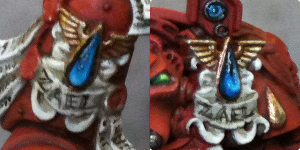| Author |
Message |
 |
|
|
 |
|
Advert
|
Forum adverts like this one are shown to any user who is not logged in. Join us by filling out a tiny 3 field form and you will get your own, free, dakka user account which gives a good range of benefits to you:
- No adverts like this in the forums anymore.
- Times and dates in your local timezone.
- Full tracking of what you have read so you can skip to your first unread post, easily see what has changed since you last logged in, and easily see what is new at a glance.
- Email notifications for threads you want to watch closely.
- Being a part of the oldest wargaming community on the net.
If you are already a member then feel free to login now. |
|
 |
![[Post New]](/s/i/i.gif) 2023/01/05 12:34:25
Subject: Best practices for painting thin, sharp lines with acrylics?
|
 |

Posts with Authority
|
As I get older, I realize I'm getting more and more obsessed with the nitty gritty of miniature modelling and painting processes. "Back to basics" I guess? What I mean is, a theory that perfectly mastering the foundations of the boring minutiae that go into making minis, such as model cleaning/prepping, assembling, priming and basecoating, are the foundations of achieving better looking end results.
To this end, I have been re-learning all of these processes bit by bit, and now think I have most of the basics internalized better. Stuff like cutting parts from the sprue loosely, then trimming the loosely cut gates from the pieces with a razor saw, followed by further scalpel cleanup, followed by sanding (going from coarser to finer grit). Washing all the parts properly before priming. Priming with purpose-made primers instead of using just any coloured paint. Using an airbrush for priming and basecoating the largest areas so as to keep paint layers as thin as possible. etc. So now, I want to re-educate myself further with the next steps of the process, which brings me to my questions..
I have always struggled in one specific area of painting the most - freehands. When I draw anything, I've always preferred technical pens, and my approach to drawing relies heavily on controlled, crisp outlines for any shapes I do. Getting sharp, thin lines, the likes of which come naturally and effortlessly from a technical pen, is very difficult to replicate with a brush and acrylic paints IME. I didn't give much thought to why this is before, but now I am.
So started looking for info about this subject online and ran into recommendations on mixing inks and stuff such as Liquitex flow aid into the paint, in order to obtain not only a thinner but equally covering consistency of paint, but also to minimizing surface tension of the paint liquid itself. This supposedly makes the paint easier to control, making technical pen -style outlining work much easier. Lowering surface tension also means my brush has to be correctly loaded, as overloading the brush will mess things up due to the paint being more runny.
Just wanted to hear Dakka's talented painters takes on the topic. Anything you'd like to share? Do you have experience with mixing inks & flowaid to paint? Something else you have learned and would like to share?
Thanks for any insight!
|
"The larger point though, is that as players, we have more control over what the game looks and feels like than most of us are willing to use in order to solve our own problems" |
|
|
 |
 |
![[Post New]](/s/i/i.gif) 2023/01/05 13:48:46
Subject: Best practices for painting thin, sharp lines with acrylics?
|
 |

Grizzled Space Wolves Great Wolf
|
I'm not great at freehand, but I like to add a touch of drying retarder so the paint flows for longer.
Some of the finer work I've done, like the name tags on the Space Hulk model which are made from super fine lines (double lines and little serifs on the text), I actually used enamel and oil paints. That was because it let me do test strokes over and over again on a bit of painted sprue until the paint was flowing perfectly and it'd keep flowing perfectly for the few minutes it took me to paint the model, and also because oil and enamel paints naturally have good flow, and also because if I screwed up I could keep manipulating the paint on the model or alternatively just wipe it off and start again.

But I'm a weirdo, other skilled painters would probably just do it with acrylics, lol.
|
|
|
 |
 |
![[Post New]](/s/i/i.gif) 2023/01/05 15:11:04
Subject: Re:Best practices for painting thin, sharp lines with acrylics?
|
 |

Crafty Bray Shaman
Anor Londo
|
Regarding painting thin lines with no variation, it's something that I never thought that I'd be able to achieve, but thankfully I was wrong. After painting numerous stripes for my Iron Warriors army it really is amazing how much better I am now.
So my advice to you would be what I did, practice painting thin grids on flat surfaces. It's very satisfying when you notice just how much better you are in a short space of time.
|
|
|
 |
 |
![[Post New]](/s/i/i.gif) 2023/01/05 16:46:32
Subject: Best practices for painting thin, sharp lines with acrylics?
|
 |

Posts with Authority
|
Thanks for your thoughts so far!
Regarding oils and enamels, that's a good point, those indeed have lower surface tension than acrylics and they can be worked almost indefinitely. Can also be removed with thinner or white spirits if messed up. However, I also want to learn how to do this with acrylics.
Practicing plays into it as well, no doubt. But for checkered patterns and hazard stripes, I prefer using the old Tamiya masking tape / stencils approach instead of freehanding them
|
"The larger point though, is that as players, we have more control over what the game looks and feels like than most of us are willing to use in order to solve our own problems" |
|
|
 |
 |
![[Post New]](/s/i/i.gif) 2023/01/05 18:36:20
Subject: Best practices for painting thin, sharp lines with acrylics?
|
 |

Crafty Bray Shaman
Anor Londo
|
 tauist wrote: tauist wrote: for checkered patterns and hazard stripes, I prefer using the old Tamiya masking tape / stencils approach instead of freehanding them
Sure, a manufactured line will always be straighter than freehand...but your freehand will never improve without practice.
I never thought that I would prefer freehand over transfers/decals, but here I am (although not for everything  ).
I won't go on about it anymore (I promise!), but I do strongly urge you to try freehanding things that you would normally stencil. The feeling of acheivement when you finally nail it is far greater, in my personal experience.
|
|
|
 |
 |
![[Post New]](/s/i/i.gif) 2023/01/05 19:37:50
Subject: Best practices for painting thin, sharp lines with acrylics?
|
 |

Posts with Authority
|
What about the paint modification treatments aspect? I have some Vallejo inks and just got a bottle of Liquitex flow aid, will be experimenting with those next to see how much they affect the outcome.
FWIW I don't really consider camouflage patterns or straight line based stuff as freehand painting as such
|
"The larger point though, is that as players, we have more control over what the game looks and feels like than most of us are willing to use in order to solve our own problems" |
|
|
 |
 |
![[Post New]](/s/i/i.gif) 2023/01/05 21:01:55
Subject: Re:Best practices for painting thin, sharp lines with acrylics?
|
 |

Deranged Necron Destroyer
|
Not very deep in this topic, but what helped me a lot with freehanding camo with relatively sharp edges was barely loading the brush, painting close to the edge of drybrushing
|
|
|
 |
 |
![[Post New]](/s/i/i.gif) 2023/01/05 23:53:38
Subject: Re:Best practices for painting thin, sharp lines with acrylics?
|
 |

Crafty Bray Shaman
Anor Londo
|
For me it depends on the thickness of the paint itself, but for freehand lines I would generally use 70:30 paint:water. I would dilute even low-pigment paints (such as GW "Layer" paints) as it will give you a much smoother and consistent finish
Use a damp brush, don't overload it or the paint will be hard to control. Just focus on touching the surface with the tip, slow repetition rather than doing the line all in one go, until you've got a feel for it. Practice on a spare rhino door panel or a plastic tile. when you are ready you can try it in one or two movements rather than many smaller movements. Repetition is important whilst practicing.
I use thumb and forefinger to hold the brush whilst using the other fingers on my hand to "anchor" my hand to the model and prevent unwanted movement. I also wear thin latex gloves if I'm concerned about touching the model and rubbing paintwork.
|
|
|
 |
 |
![[Post New]](/s/i/i.gif) 2023/01/06 07:36:25
Subject: Best practices for painting thin, sharp lines with acrylics?
|
 |

Fireknife Shas'el
|
I use a “leader” brush for thin lines (it’s about 2-3 times longer than a standard brush for the width). I find it easier to do smooth strokes, plus it has more belly to store paint.
|
|
|
|
 |
 |
![[Post New]](/s/i/i.gif) 2023/01/08 08:20:21
Subject: Best practices for painting thin, sharp lines with acrylics?
|
 |

Posts with Authority
|
After yesterday's experiments (tried various brushes and mixtures of paint & thinner & flow aid, as well as my fiancé's reading glasses), I think I need to invest in a decent pair of +2.25 reading glasses before anything else hehehe!
Seriously, don't sleep on them. Comfort, price and utility is superior to any magnifying lens stuff I've tried. Then again, I have serious eyesight deficiencies so YMMV
|
|
This message was edited 3 times. Last update was at 2023/01/08 08:23:25
"The larger point though, is that as players, we have more control over what the game looks and feels like than most of us are willing to use in order to solve our own problems" |
|
|
 |
 |
![[Post New]](/s/i/i.gif) 2023/01/08 20:39:08
Subject: Best practices for painting thin, sharp lines with acrylics?
|
 |

Ancient Venerable Dreadnought
|
I totally recommend using pinstriping brushes. They generally have a huge well and a long progressive tip that gives a ton of control.
|
|
|
 |
 |
|
|